This post may contain affiliate links. Please read our disclosure policy.
Our mouthwatering and easy Prime Rib recipe features a garlic seasoning that elevates both boneless and bone-in standing rib roasts. With simple steps, helpful tips, and foolproof instructions, you’ll serve up a perfectly cooked, show-stopping dish every time. Special occasions just got stress-free!
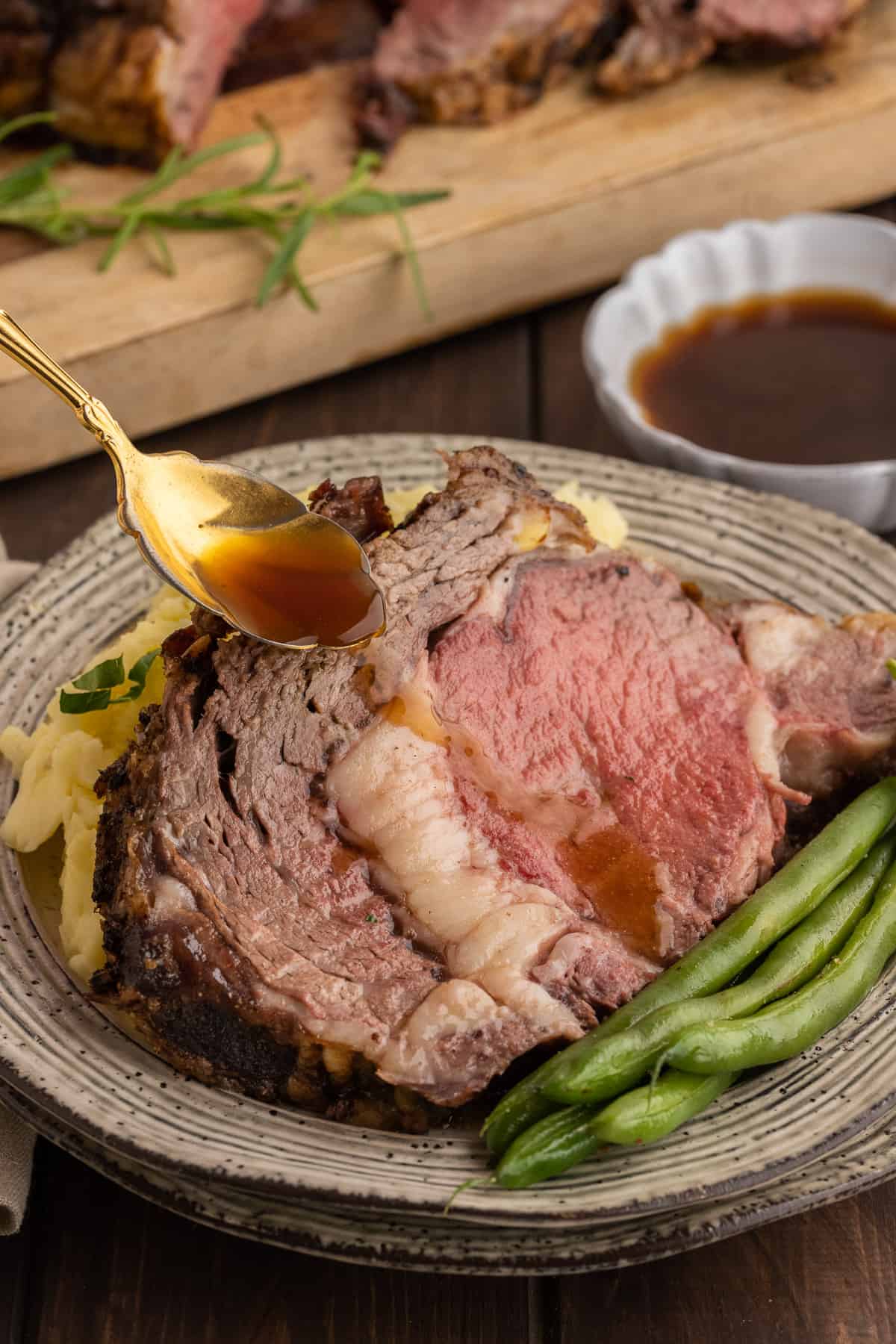
Nothing says a special occasion like a perfectly cooked Prime Rib, and I promise it’s easier than you think! Every holiday season, depending on whether I’m hosting Christmas or New Year’s Eve, this roast always finds its way onto our menu. If it’s Christmas, it’s the centerpiece of our dinner, and for New Year’s Eve, it’s the perfect way to kick off the festivities with family and friends. No matter which holiday I’m hosting, this prime rib is my go-to, bringing everyone together around the table.
Over the years, I’ve experimented with different methods, like the “cook high and turn the oven off” trick, where the roast sits for two hours. While it’s an interesting approach, I’ve always come back to my tried-and-true method because it delivers the most consistent and delicious results. The garlic seasoning and perfectly tender meat never disappoint, and I can’t wait for you to make it a part of your holiday celebrations, too!
Nikki’s Recipe Rundown
- Taste: Rich, savory flavor with garlic seasoning that perfectly complements the prime rib without overpowering.
- Texture: Tender, juicy meat with a beautiful crust on the outside—just melts in your mouth. This tender cut of meat is the star of the show here.
- Ease: Super simple! Just follow the steps, and you’ll have a perfect roast every time.
- Pros: Minimal prep but huge flavor—just the kind of recipe I love. Works great with either bone-in or boneless, and it never fails to impress.
- Considerations: Timing is everything, so I always recommend using a meat thermometer. Prime rib can be a bit of a splurge, so follow the steps carefully to get it just right.
- Recipe Repeatability: Absolutely! This is one you’ll come back to year after year. This one’s been my go-to for years, especially during the holidays.
People often think cooking Prime Rib is difficult, but really, that is far from the truth. Although I understand the hesitation, this cut of meat is expensive (it’s like an investment). You are usually preparing it for guests or a crowd (no pressure, right), and you really don’t want to mess it up!
So, let’s talk about Prime Rib and how to be successful in making one each and every time. It’s really a breeze, y’all!
What is Prime Rib?
A “Prime Rib Roast” is also known as a rib roast or “standing rib roast“. You can find it in both bone-in and boneless options. So, what cut of meat is a prime rib? It is a cut that is taken from the back of the upper ribs (rib primal) of the cow. It’s the same cut where ribeye steaks come from and gives you a rich, beefy flavor. The cut has generous marbling, giving you that tender, buttery texture we love.
How to Cook Prime Rib in the Oven
✱ Be sure to see the recipe card below for exact ingredients and full recipe instructions!
Step 1 | Salt Roast & Let it Come to Room Temperature
Remove your prime rib from the refrigerator at least 3 hours before cooking. Season it on all sides with salt about 2 teaspoons (or to taste) and cover it loosely with plastic wrap as it comes to room temperature. Prime rib roast will cook better and more evenly when it’s at room temperature.
If using a boneless roast, I suggest you place a roasting rack inside the pan.
Step 2 | Prepare the Oven
When you are ready to cook the prime rib, lower/adjust your oven rack so the meat will cook in the center of the oven.
Preheat the oven to 500°F (or the highest temperature your oven will reach if it won’t go up to 500°F).
Step 3 | How to Tie a Prime Rib Roast
If needed, I wanted to share instructions on how to do this. (This is usually done by the butcher):
Pre-cutting away the bones is definitely optional but does make it easier to carve the roast. You will remove the bones and then re-attach them with kitchen string to keep all of the buttery flavor and juiciness of this beautiful cut of beef.
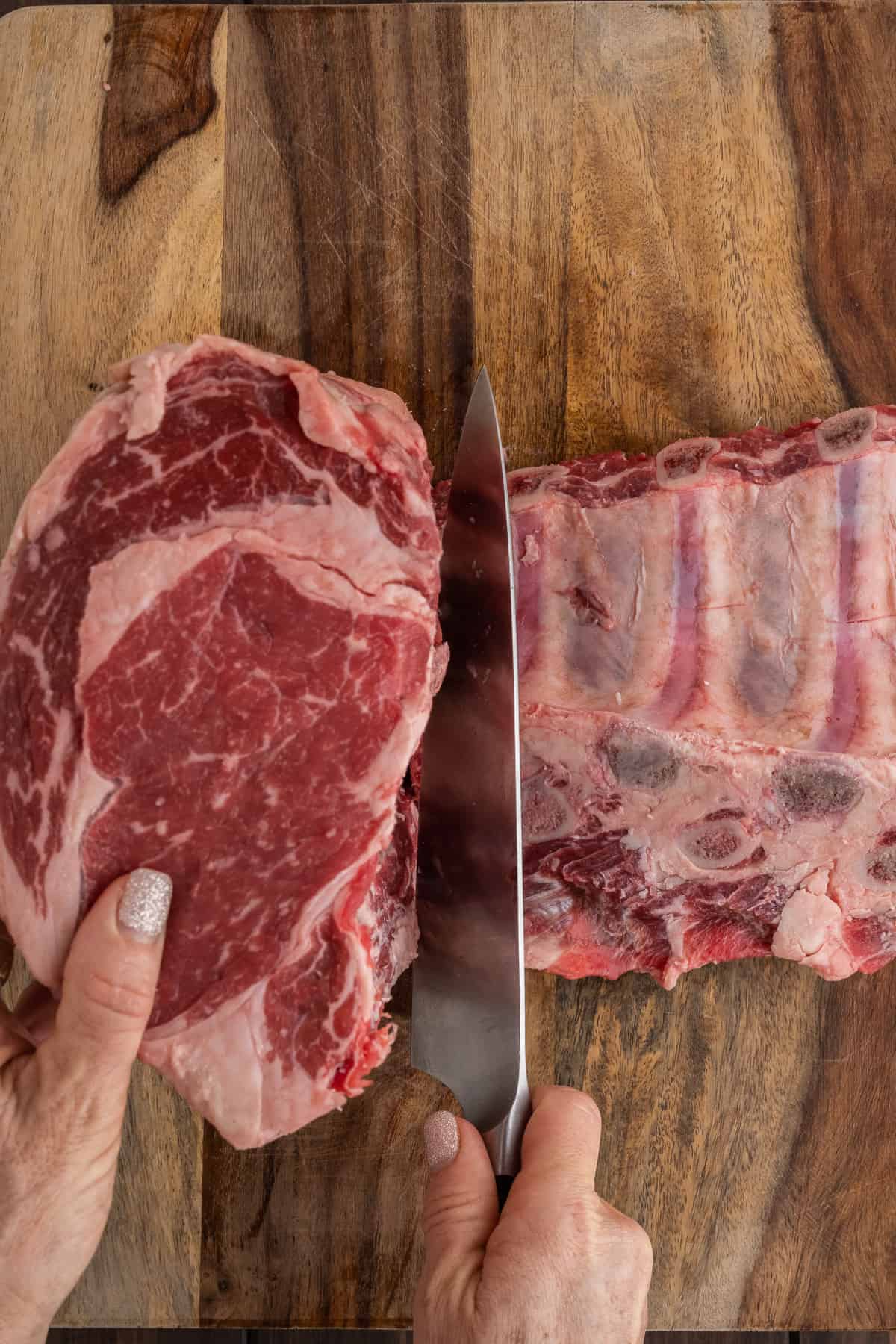
Using a sharp knife, carefully cut away the bones by running your knife just above the rib bones. Fold or place the roast back down over the bones.
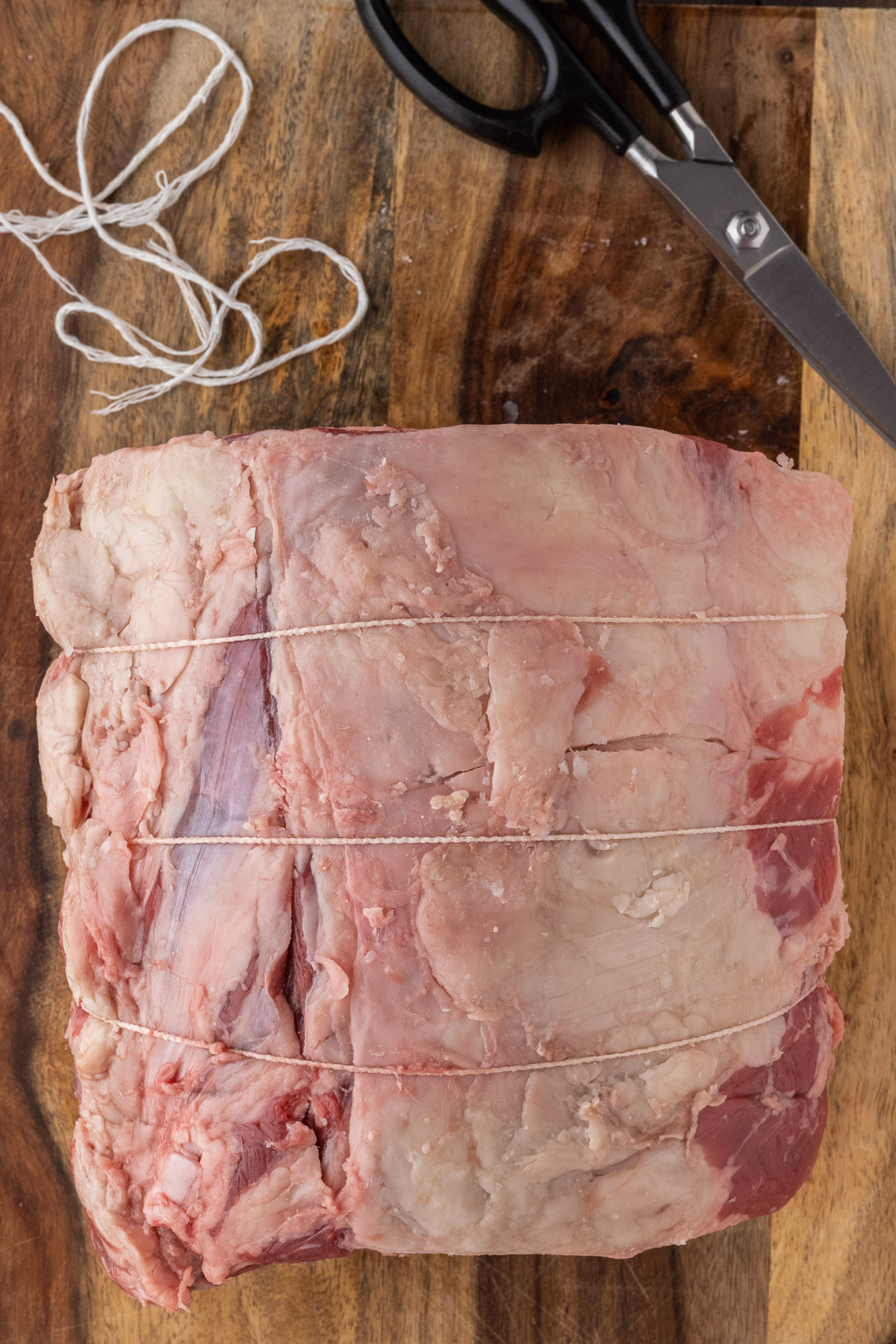
Then, tightly wrap with kitchen string around the bones in about 1-inch intervals, and secure the tying tightly.
Remember, a butcher can cut this away and tie it for you (usually free of charge). During the holiday seasons, you will often find them already prepped like this in your grocery stores.
This allows the roast to cook standing on the rib bones (a lot of flavor in those bones). This makes it much easier to carve the roast after cooking.
Step 4 | How to Season Prime Rib
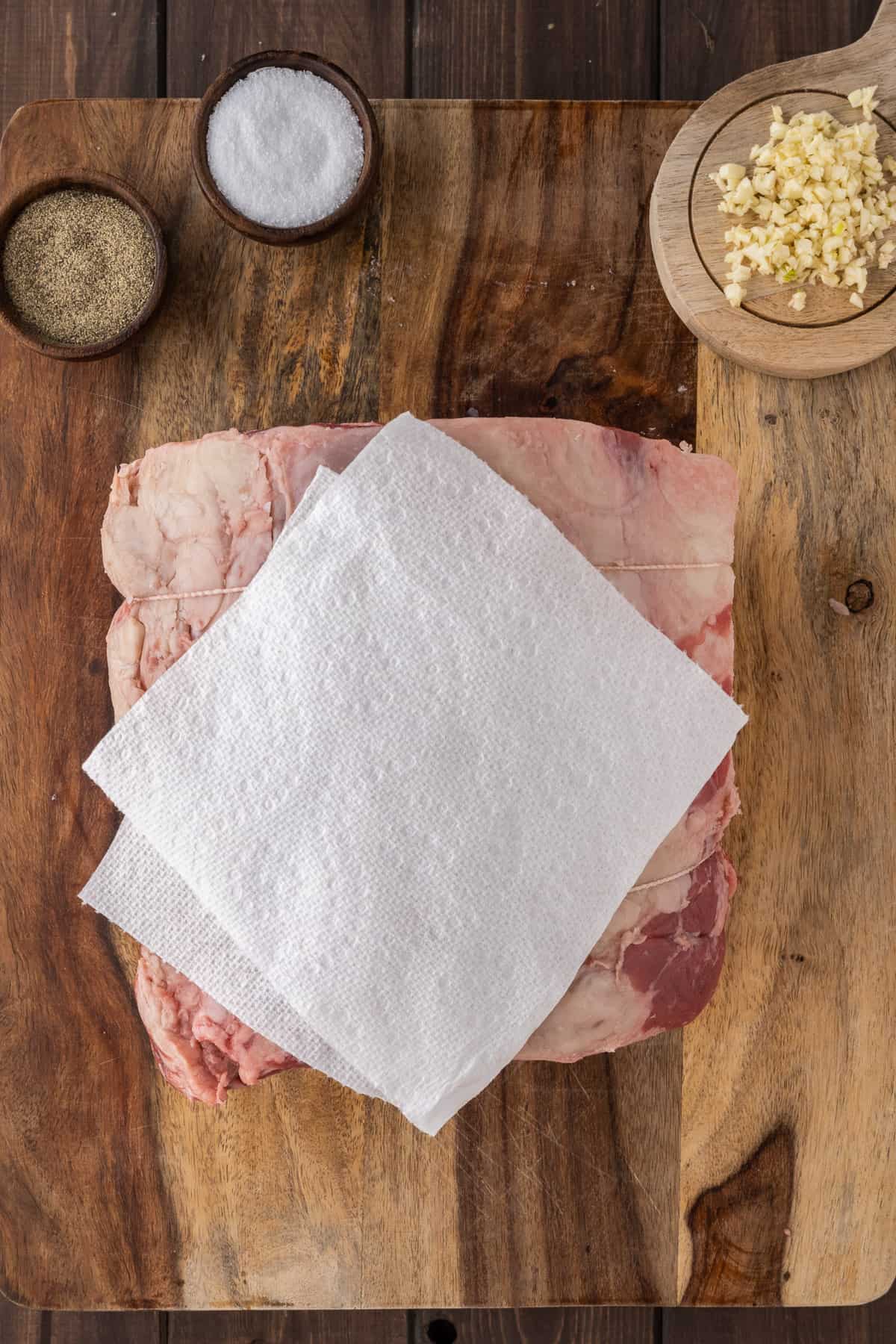
Pat the roast with paper towels. Adding a little salt while it comes to room temperature will draw a little moisture out.
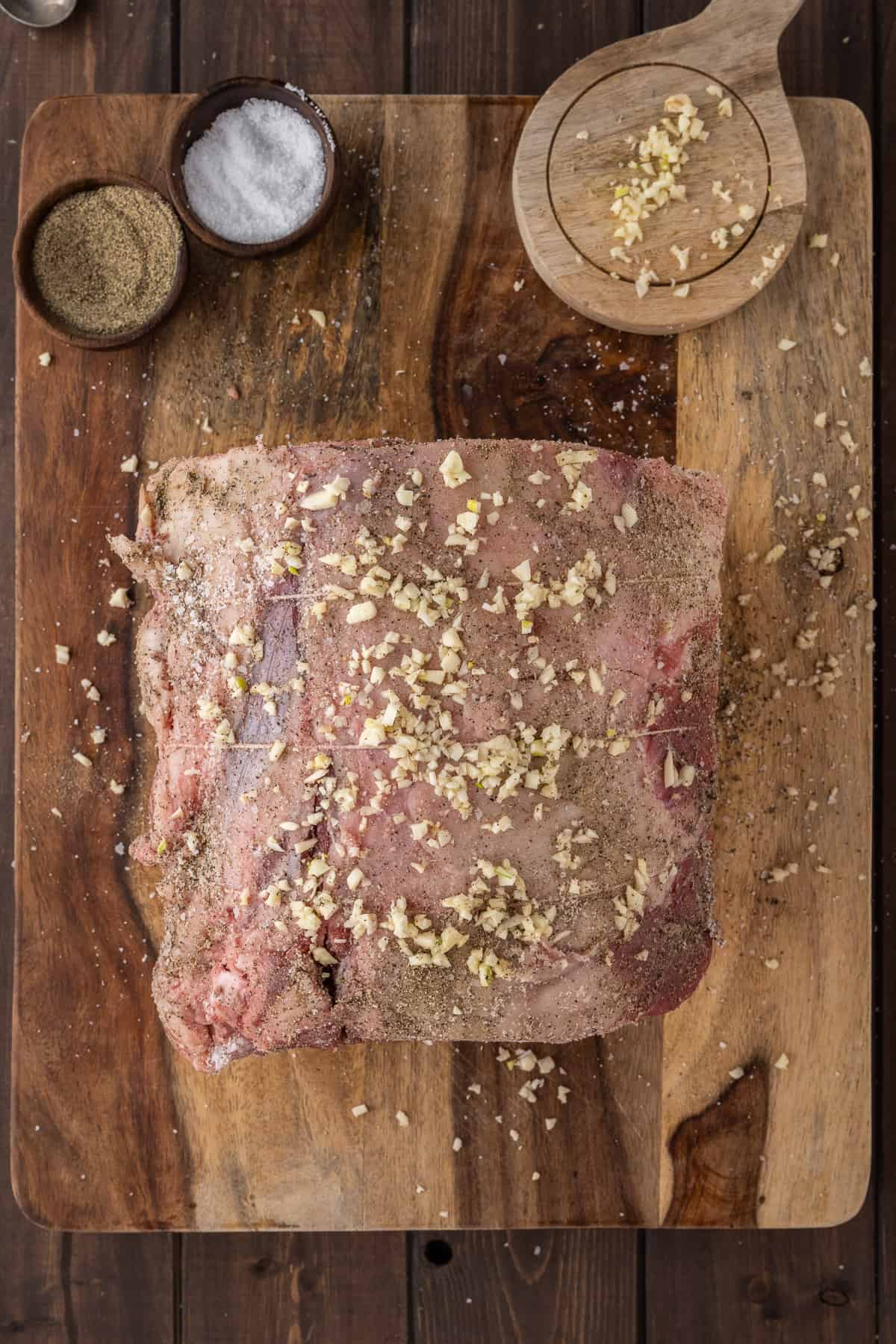
Sprinkle on salt, pepper, and minced garlic on top. I use ½ tablespoon each of salt and pepper and 6 cloves of garlic on a 7-pound roast. You can adjust it according to your taste and the size of the roast.
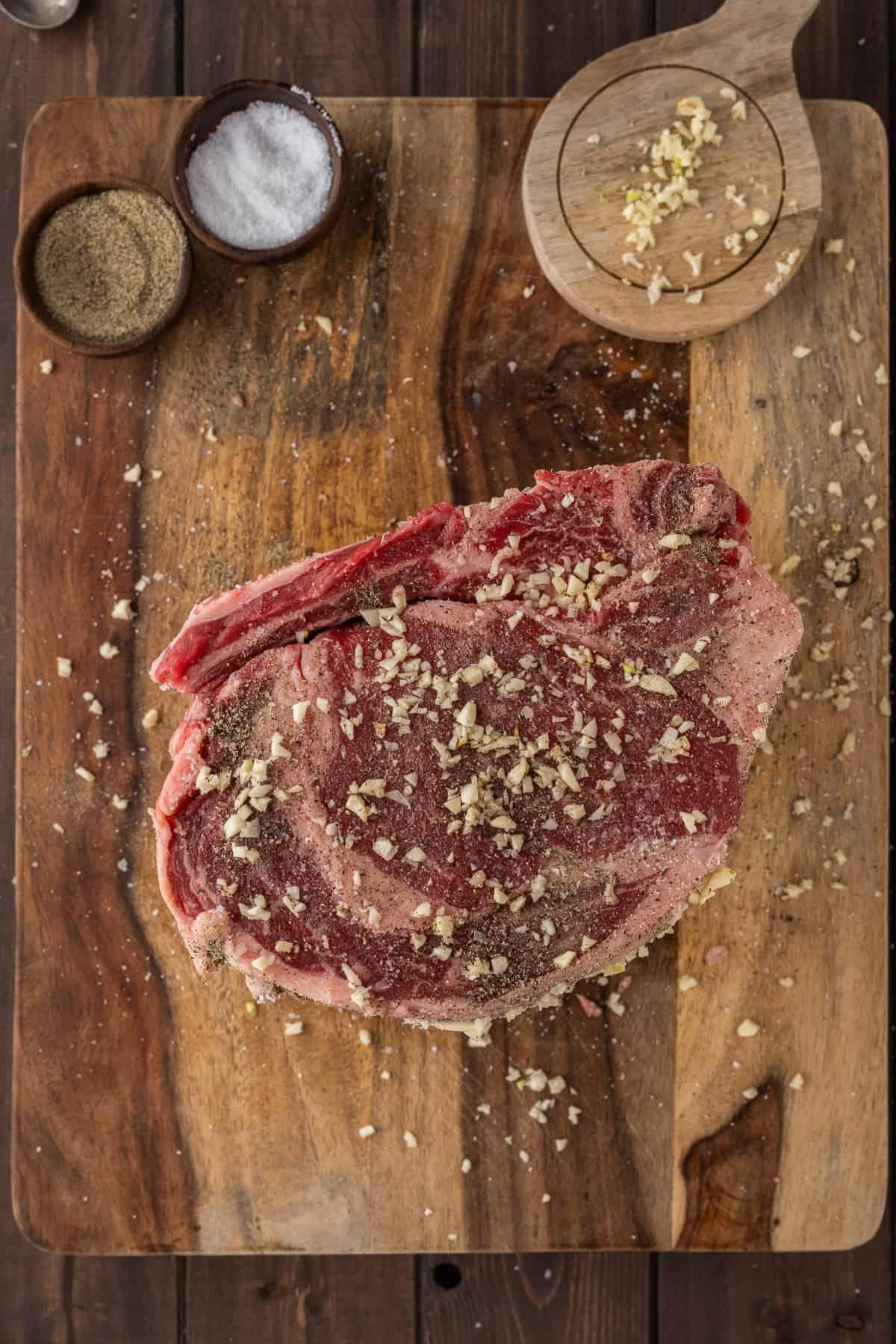
Be sure to cover all the sides of the roast.
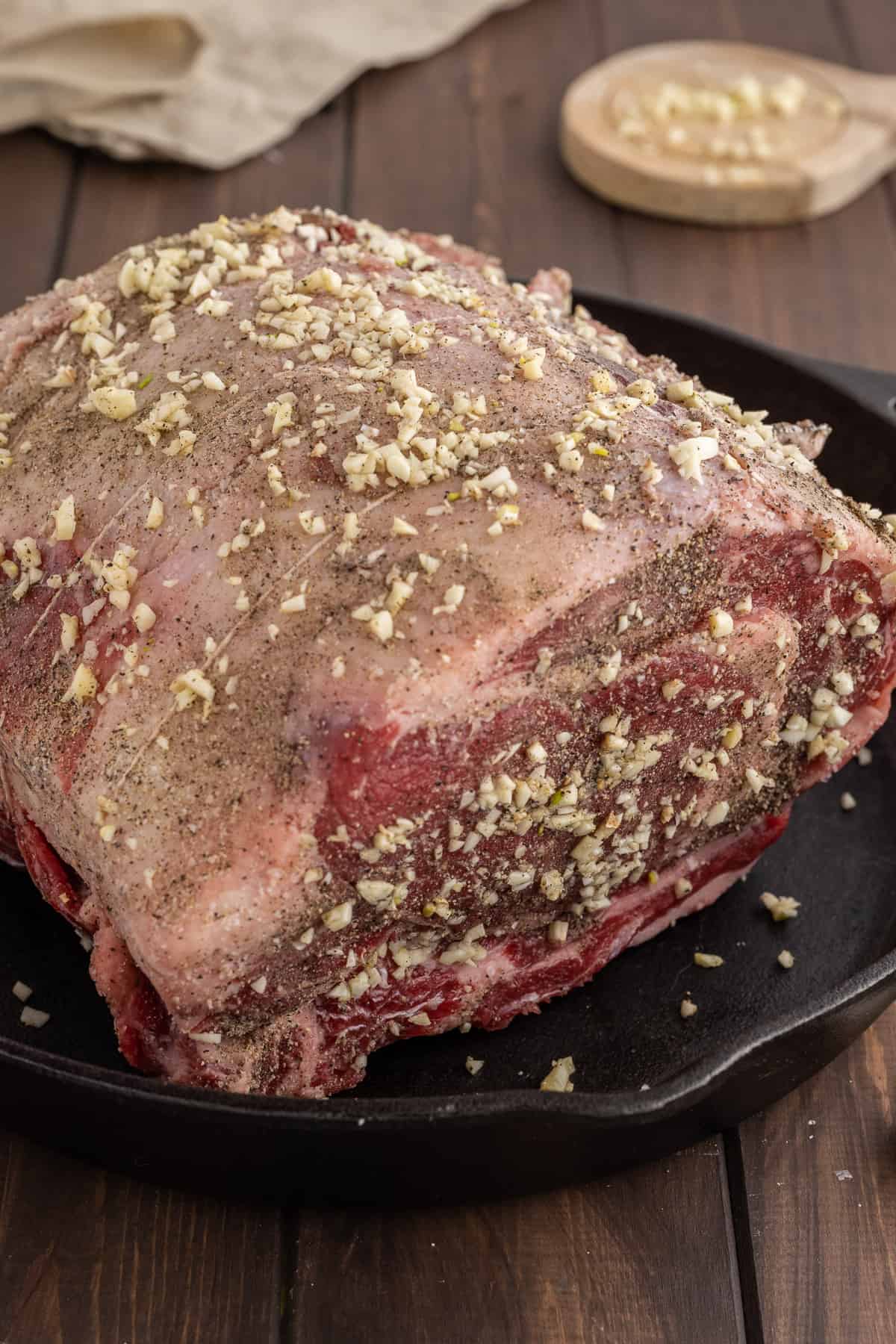
Place bone-in roast with the bone side down (fat side up) inside a roasting pan or a cast iron pan.
If using a boneless roast, don’t forget to place it on a roasting rack inside the pan.
Step 5 | Roast the Prime Rib
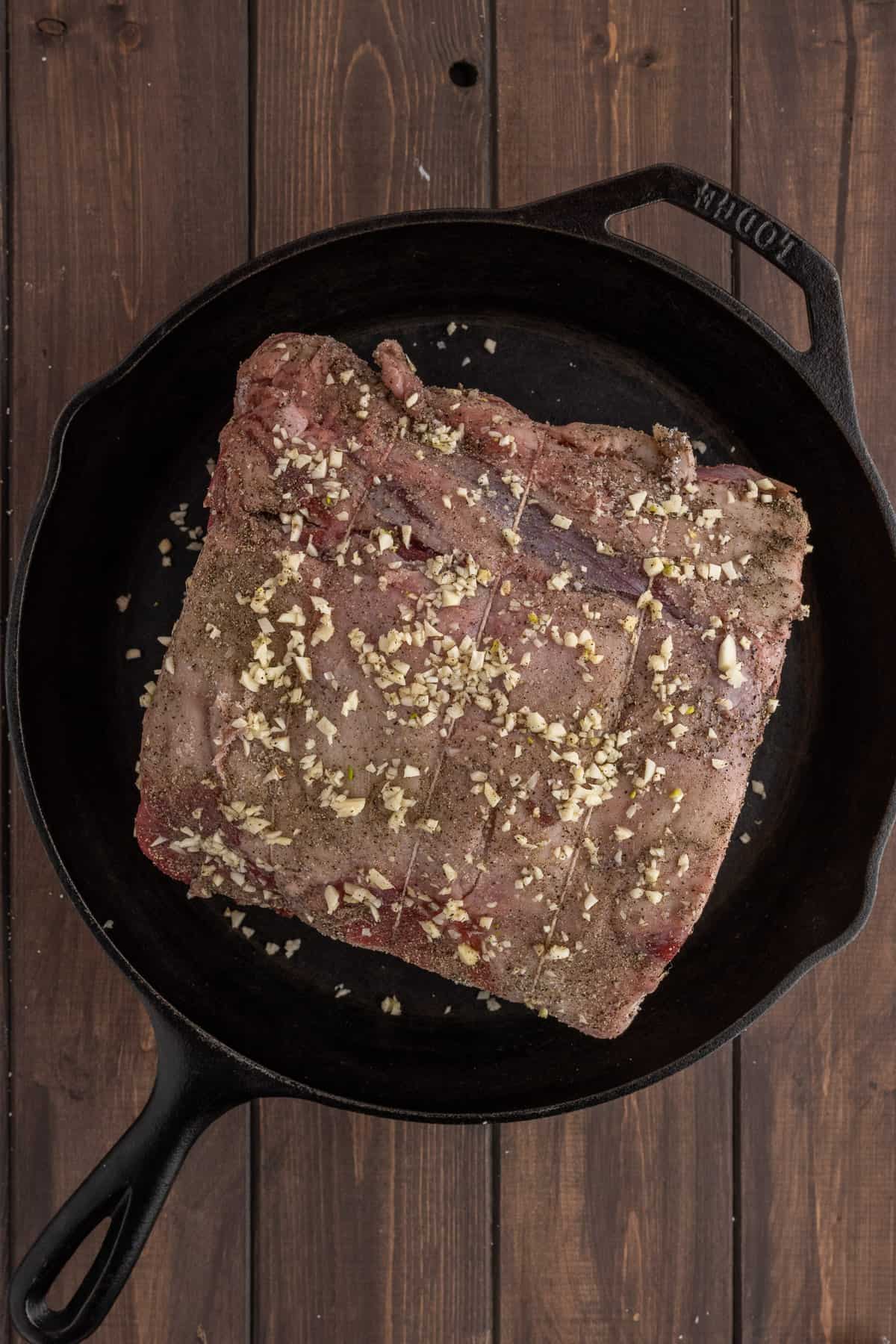
You can use any pan that can withstand high temperatures (500°F) and one that will fit the size of the roast you have. Just be sure there is room around the roast for air to circulate.
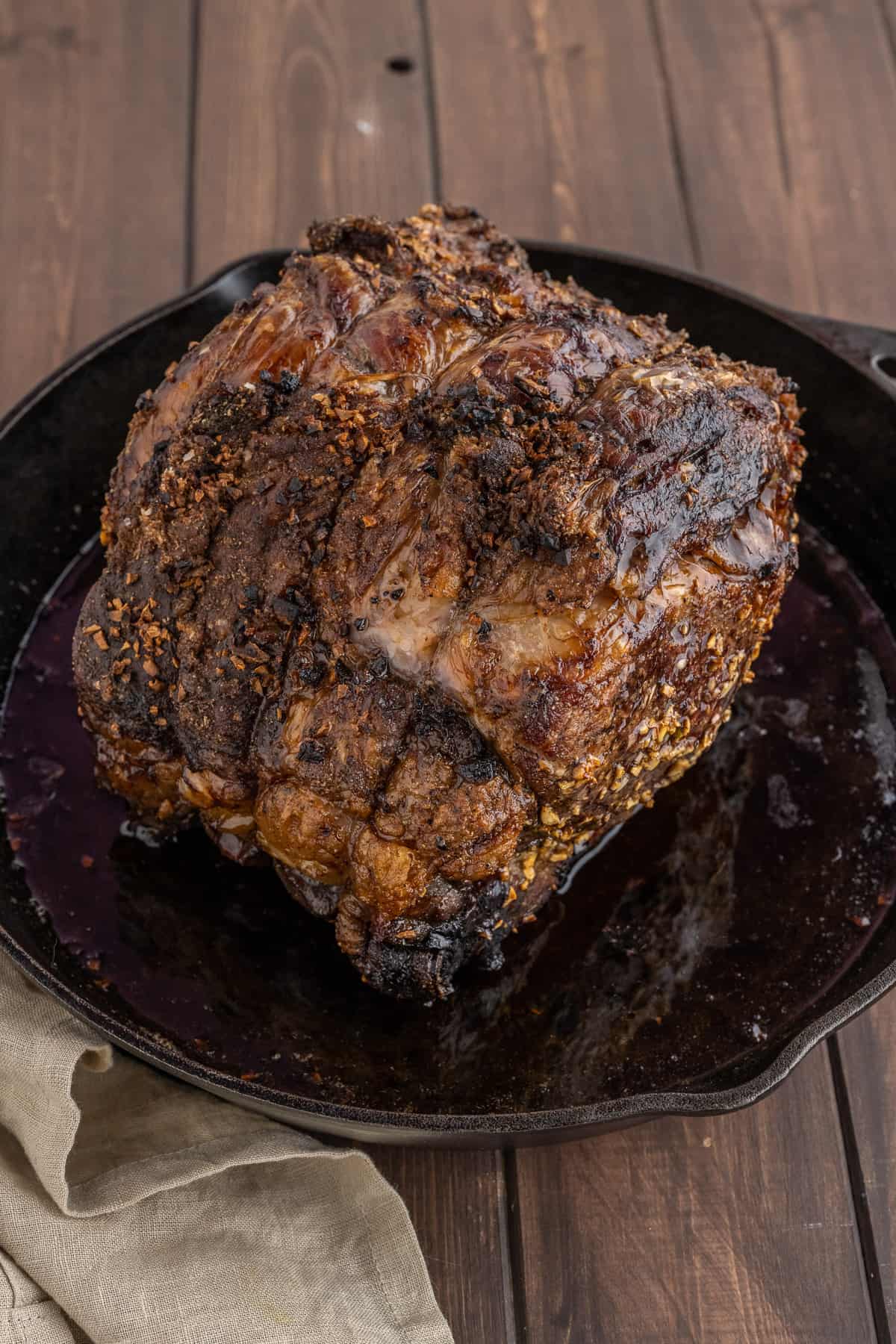
First, bake prime rib at high heat. Then reduce the oven temperature (no need to remove the roast) and continue baking until the desired doneness is reached:
How Long to Cook a Prime Rib
How long you cook the prime rib will depend on how rare you prefer your meat.
Using an oven-safe (leave-in) meat thermometer will ensure the most accurate cooking. You can also test it with an instant-read thermometer if that is all you have on hand. BUT I highly suggest investing in an oven-safe one. They are fairly inexpensive and will give you the best results.
Also, I like to keep an eye on the roast and check on the temperature. Just take a look at the thermometer a few times during the cooking to be sure not to overcook this glorious cut of beef.
COOKING TIME for Prime Rib
Start by cooking the prime rib in a pre-heated 500°F oven for 15 minutes and then lower your oven temperature to 325° and continue baking for:
- 10-12 minutes per pound for rare
- 13-14 minutes per pound for medium-rare
- 14-15 minutes for medium
- 16-17 for medium-well
THERMOMETER TEMPERATURE REGISTERS for Prime Rib
- 115-120°F for rare – bright red in the middle
- 125-130°F for medium rare – warm red in the middle with slight pink around the edges
- 135-140°F for medium-warm pink through
- 145-150°F for medium well – slightly pink at the center
- 160°F for well done – little to no pink throughout. The meat will be on the dryer side.
REMEMBER: As the prime rib roast rests, the internal temperature will rise 5 to 10 degrees
Internal temperature should reach at least 125℉ to ensure it’s safe to eat.
How to Carve Prime Rib
Once out of the oven, let the roast sit for 30 minutes before serving. If you don’t let the roast rest, you will lose all those delicious juices, and the meat can become somewhat chewy.
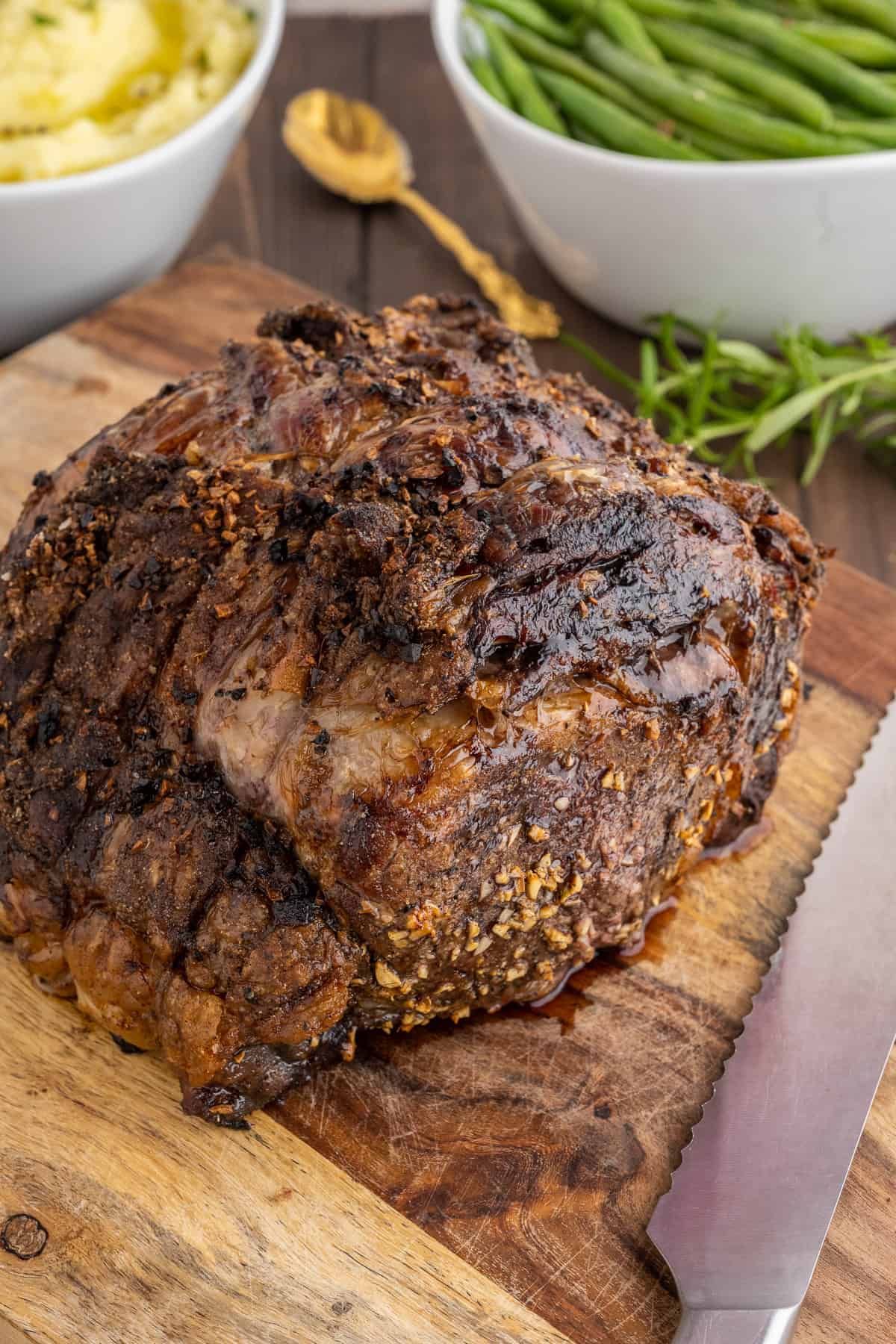
Cut away the kitchen strings that were securing the ribs to the roast. Then, remove the bones.
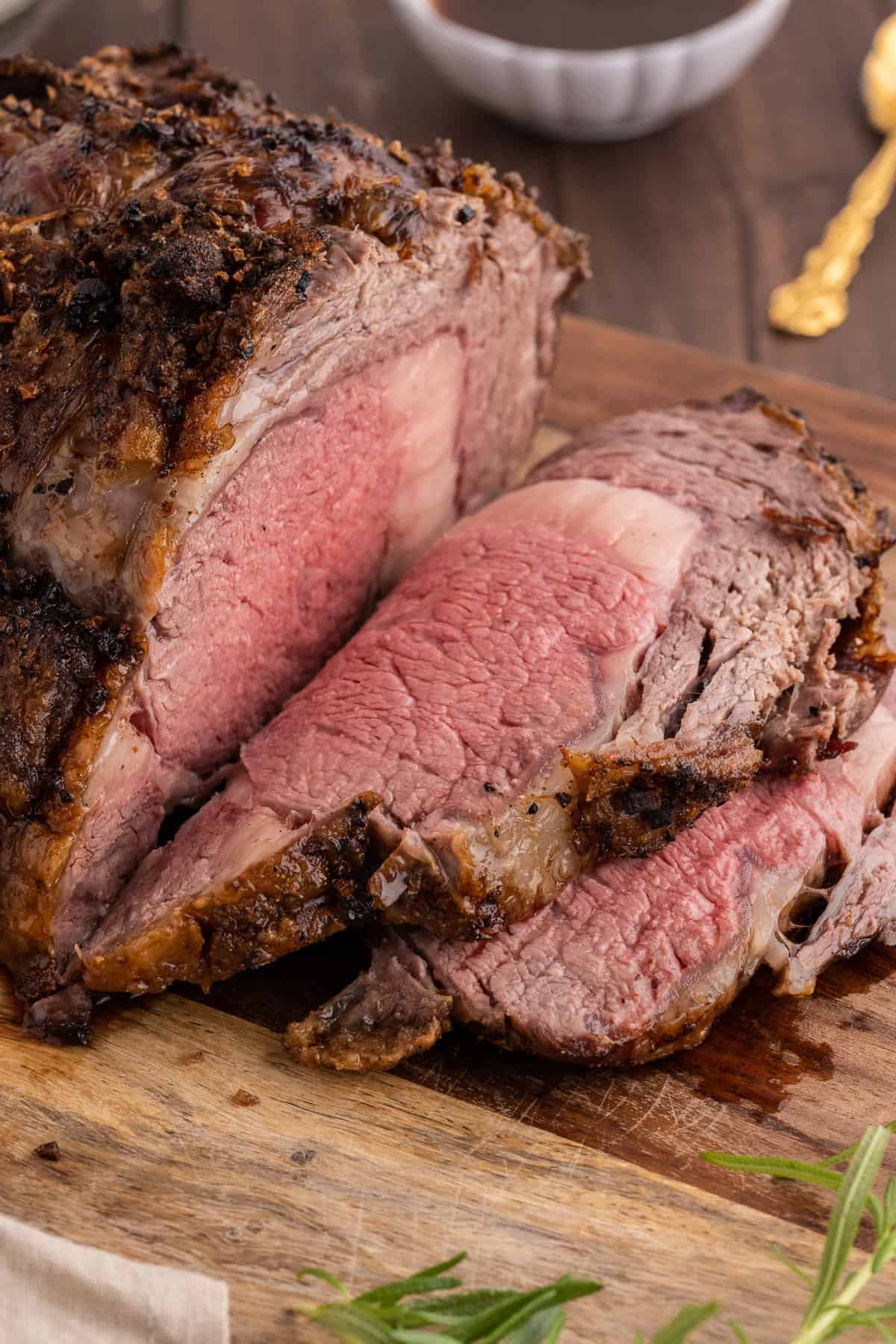
Next, carve by slicing against the grain at about ½ to ¾ inch thickness (or desired thickness). Some restaurants will serve a 1-inch thick slice, but I prefer a slightly thinner slice.
Prime Rib Roast Recipe Variations & Substitutions
Want to Save this Recipe?
By submitting this form, you consent to receive emails from Soulfully Made.
Tips
- Use a meat thermometer: Using a meat thermometer is essential to ensure it cooks to your perfect doneness. Keep in mind not all ovens will cook the same.
- Let it sit out before cooking: All roasts or cuts will cook a little differently to begin with. Having the meat at room temperature will help it cook more evenly. Be sure to plan for this in your meal prep time.
- Don’t overcook: The meat will continue to cook once it’s taken out of the oven (you will see the thermometer will continue to rise 5-10 degrees), so remove it from the oven 5-10 degrees before it reaches your optimal temperature. Keep in mind that the shape of the roast can also factor into the cooking time. This, again, is why I suggest a thermometer.
- Cut the meat across the grain: You will be looking at the grain or lines in the beef and slicing them perpendicular to them. Cutting along the grain will make the meat chewier and tougher to eat.
- Carve one slice of roast per guest and leave the rest of the roast intact until more servings are needed. This helps retain its flavorful juices and will keep the roast warmer.
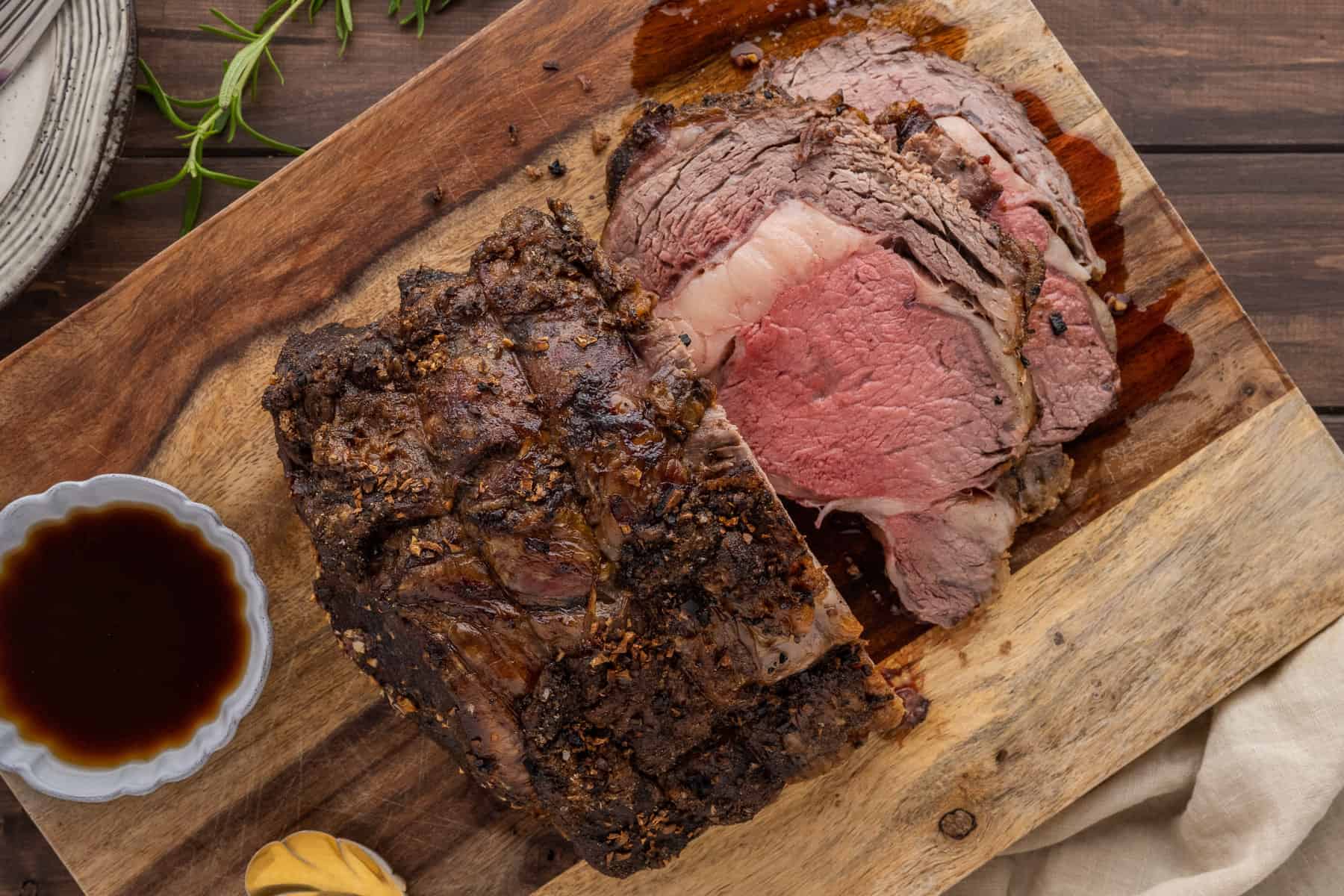
What to Serve with Prime Rib?
Looking for a classic holiday Prime Rib Menu that everyone is sure to love?
For a potato dish, I have you covered from Creamy Mashed Potatoes, Loaded Mashed Potatoe Casserole, to Au Gratin Potatoes. Of course, you can also do a simple baked potato with this roast.
For veggies, you can keep it simple with steamed green beans or go all out with southern-style green beans.
Round it out with a green salad and rolls, and of course, don’t forget dessert! A classic cheesecake, Biscoff cheesecake, or a slice of easy coconut cream pie works nicely. For all you chocolate lovers, try triple chocolate mousse cake or my family’s favorite southern red velvet cake.
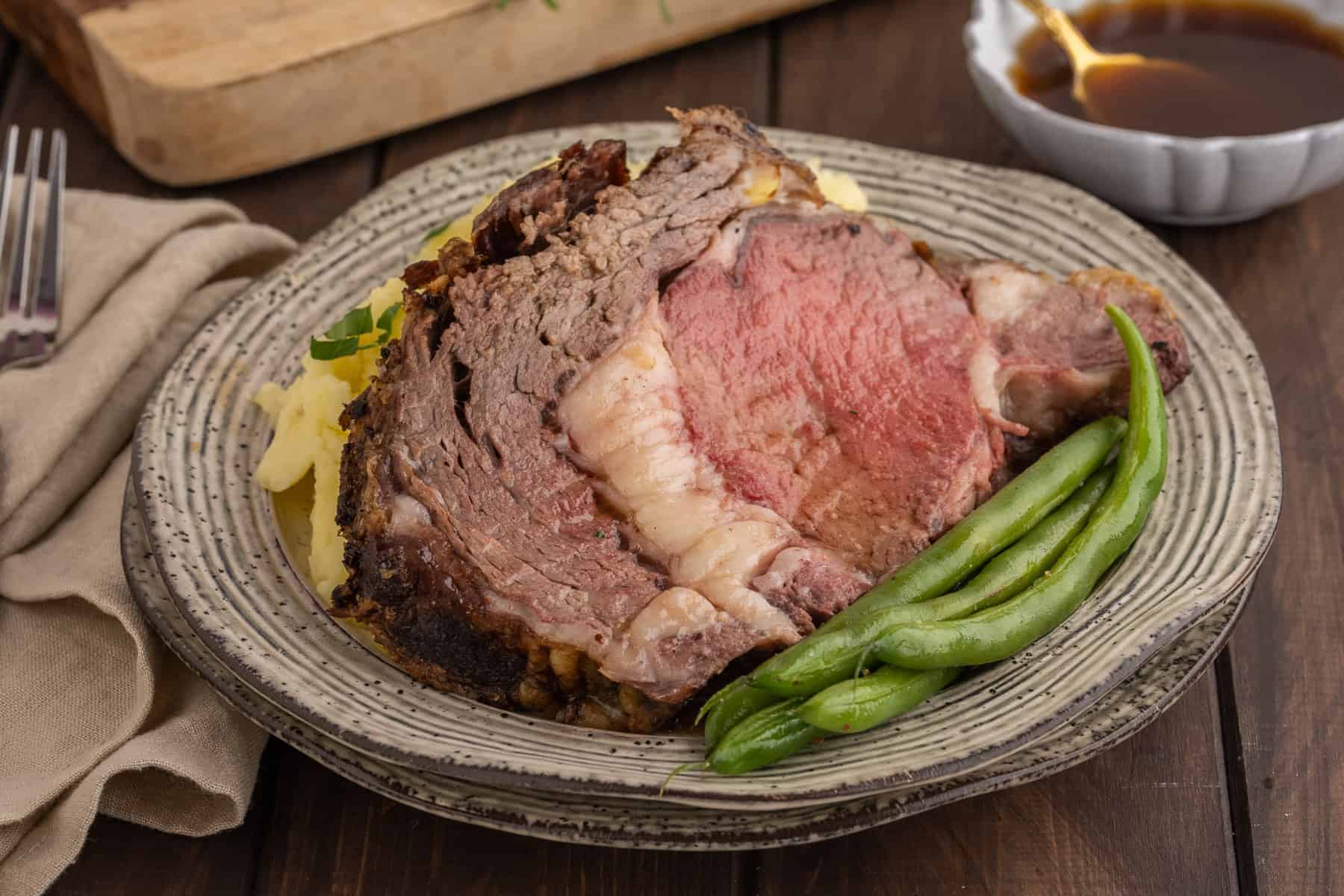
How to Store Prime Rib
Storage: Cover with foil or plastic wrap or place in an airtight container and store in the refrigerator for 3 days.
How to Reheat Prime Rib
Here’s how I like to reheat prime rib to keep it tender and delicious:
- Oven Method (great for larger pieces): Preheat the oven to 250°F. Place the prime rib in a baking dish with a little beef broth or leftover au jus to keep it moist. Cover with foil and warm it for 20-30 minutes or until heated through. This keeps it juicy and avoids overcooking.
- Stovetop Method (with a steamer basket): Bring about an inch of water to a simmer in a pot and place a steamer basket over it. Wrap the prime rib slices in foil and place in the steamer basket. Cover the pot with a lid and let the steam gently warm the meat for about 3-5 minutes, or until heated through. This method keeps the meat moist and evenly warmed without drying it out.
- Stovetop Method (without steamer basket): Warm a bit of beef broth or au jus in a skillet over low to medium heat. Place the prime rib slices in the skillet, cover with a lid, and heat for a few minutes until warmed through.
- Sous Vide Method: If you have a Sous Vide this method works great! Seal the prime rib in a vacuum-sealed or freezer-safe bag. Place it in a pot of water heated to about 135°F for medium-rare (or adjust slightly for your preferred doneness) and let it warm for about an hour. This method helps the meat stay super moist and tender.
- Microwave Method (quick option): Place slices in a microwave-safe dish, add a splash of beef broth, and cover loosely with a damp paper towel. Microwave in 30-second intervals at 50% power, checking until it’s warm.
Avoid using high heat, as this can dry out the meat and change its texture.
What to Do with Leftover Prime Rib
Leftover prime rib is a treat! Here are some delicious ways to use it up:
- Prime Rib Sandwiches: Slice the prime rib thin and layer it on a toasted roll with horseradish sauce, caramelized onions, and melted cheese for a hearty sandwich.
- Beef Stroganoff: Dice the leftover prime rib and add it to a creamy mushroom and sour cream sauce. Serve it over egg noodles for an easy, comforting dinner.
- Prime Rib Tacos: Chop the meat into bite-sized pieces and add to warm tortillas. Top with pico de gallo, avocado, and a squeeze of lime for flavorful steak tacos.
- Steak and Eggs: Warm slices of prime rib and serve them alongside eggs for a luxurious breakfast or brunch. Or add it to your favorite breakfast casserole.
- Beef Fried Rice: Dice the prime rib and toss it into fried rice with veggies, scrambled egg, and a splash of soy sauce for a quick and tasty meal.
- Shepherd’s Pie: Use chopped prime rib as the base for a shepherd’s pie. Add mixed vegetables and gravy, then top with mashed potatoes and bake until golden.
- Beef Soup or Stew: Add chunks of prime rib to a pot of beef broth with vegetables and barley or noodles for a hearty soup.
- Philly Cheesesteak Skillet: Sauté sliced prime rib with bell peppers, onions, and provolone cheese for a quick, one-pan meal. Or make Philly Cheesesteak Sliders with the leftovers.
Foolproof Prime Rib Roast Recipe FAQs
A full rack of prime beef is a 7-rib roast, this will serve about 14 to 16 people.
Most butchers will say that each rib will typically feed about 2 people, I tend to agree. I like to serve a generous portion or count on some leftovers. But you can stretch it a little further than that (more like 3 people), especially if you are serving several sides, appetizers, and desserts.
Also, 1 pound per person is a good rule of thumb to follow, especially when using a boneless rib roast. Still, keep in mind how many sides you are serving as well. If you have a lot of other dishes, you may go with ¾ pound per person.
I really prefer a bone-in prime rib. They are tender and full of buttery flavor when cooked with the bone in. Not to mention, you have a built-in cooking rack. Some people feel a little intimated by the thought of cutting the roast with a bone in it. The butcher will typically cut away the bone and then attach it with kitchen string for you for no extra charge. This is the best of both worlds. And during the holidays I find you can find them already ready for you this way and if not just ask for one.
If you are making a boneless one, just look for that nice fat marbling so that your prime rib will be nice and tender.
USDA Prime or Choice? The USDA Grading tells you the tenderness and juiciness of the cut of meat you are purchasing. Typically, in most grocery stores, you will find a choice of cut of meat. If you want to really splurge, you can ask for a Prime Grade, which is given to the best cuts of beef. Just realize there is a significant price difference between the two cuts.
Hungry for more easy, home-cooked, delicious recipes?
Sign up for my free recipe club to get family-friendly recipes in your inbox each week! Find me sharing daily meal-time inspiration on Pinterest, Facebook, and Instagram.
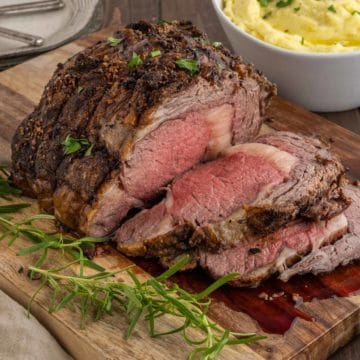
Foolproof Standing Rib Roast (Prime Rib Roast Recipe)
Ingredients
- 1 7-10 pound Standing Rib Roast / Prime Rib (bone-in), 3 to 7 ribs (estimate about 2 people per rib), bones cut away and tie to roast with kitchen string. I get mine already prepped by the butcher. Instructions are below for how to do this and how to make a boneless one.
- ½ tablespoon kosher salt plus 2 tablespoons , (or to taste)
- ½ tablespoon coarse black pepper, (or to taste)
- 6-8 cloves fresh garlic, roughly minced, (or to taste)
Instructions
- Salt Roast & Let Come to Room Temp: Remove your prime rib from the refrigerator 3 hours before cooking. Season it on all sides with salt (2 teaspoons or to taste) and cover it loosely with plastic wrap as it comes to room temperature. Prime rib roast will cook better and more evenly when it’s at room temperature. If using a boneless roast, place a roasting rack inside the pan.
- Prep- Oven: When you are ready to cook the prime rib, lower/adjust your oven rack so the meat will cook in the center of the oven. Preheat the oven to 500°F.
- Tie Rib Bone in Rib (If not done by butcher): If the ribs are not cut away from the roast go ahead and do so and then tie them to the roast with kitchen string. This allows the roast to cook standing on the rib bones (flavor), while making it easier to carve the roast after cooking.
- Season & Prep Prime Rib: Pat the roast with paper towels. Spoon seasoning over it, rubbing it on all sides. Place bone-in roast with the bone side down (fat side up) inside a roasting pan or a cast iron pan (any pan that can withstand 500° temperatures). If using a boneless roast, place it on a roasting rack inside the pan.
- Brown Roast at High Temperature & Lower Temp to Finish Roasting Prime Rib: Bake prime rib at 500° for 15 minutes, then reduce the oven temperature to 325° and continue baking until the desired doneness is reached: Rare: cook until thermometer reaches 120 degrees F (about 10-12 min/pound)Medium rare: Cook until thermometer reaches 130 degrees F (about 13-14 min/pound)Medium: Cook until thermometer reaches 140 degrees F (about 14-15 min/pound)Medium well: Cook until thermometer reaches 150 degrees F (about 16-17 min/pound)Note: The internal temperature will continue to rise 5-10 degrees when it comes out of the oven (while resting), so do not over bake.
- Let Roast Rest: Remove the prime rib from the oven, transfer to a cutting board, and loosely tent it with foil. Allow it to rest for 30 minutes before carving.
- Slice & Serve: Cut away the kitchen strings that were securing the ribs to the roast. Remove the bones. Carve by slicing against the grain at about ½ to 3/4 inch thickness (or desired thickness). Serve with Au Jus, Gravy, (recipes below) or whipped horseradish, if desired.
Want to Save this Recipe?
By submitting this form, you consent to receive emails from Soulfully Made.
Notes
- Use a meat thermometer: Using a meat thermometer is essential to ensure it cooks to your perfect doneness. Keep in mind not all ovens will cook the same.
- Let it sit out before cooking: All roasts or cuts will cook a little differently to begin with. Having the meat at room temperature will help it cook more evenly. Be sure to plan for this in your meal prep time.
- Don’t overcook: The meat will continue to cook once it’s taken out of the oven (you will see the thermometer will continue to rise 5-10 degrees) so remove it from the oven 5-10 degrees before it reaches your optimal temperature. Keep in mind the shape of the roast can also factor in on cook time. This again is why I suggest a thermometer.
- Cut the meat across the grain: You will be looking at the grain or lines in the beef and slicing them perpendicular to them. Cutting along the grain will make the meat chewier and tougher to eat.
- Carve one slice of roast per guest and leave the rest of the roast intact until needed more servings. This helps retain its flavorful juices and will keep the roast warmer.
- Place the roasting pan on the stovetop over medium-high heat. Remove excess fat. Leave about 1 ½ cups of drippings and juices from the roast in the pan. Stir in 2-3 teaspoons Worcestershire (or to taste) sauce with ½ cup red wine, scraping up bits (drippings) from the bottom.
- Simmer for about 4 minutes, and reduce to desired consistency.Taste and adjust seasonings as needed.
- Spoon off any excess fat from the top or pour through a fine mesh sieve if desired and serve.
- Remove the roast from the pan. Remove excess fat. Leave about ¼ cup of drippings and juices from the roast in the pan.
- Place the pan on the stovetop (or pour it into a stovetop-safe pan) over medium-high heat. Use a wooden spatula to scrape or loosen the drippings from the bottom of the pan.
- When the drippings are bubbly and hot, sprinkle in ¼ cup of all-purpose flour over the fat and drippings. With a whisk stir to incorporate the flour into the fat drippings. Let the flour cook for 1-2 minutes to slightly brown and cook the flour.
- Slowly add in 3-4 cups of milk or beef stock (or a combination) while whisking together, breaking up any lumps that may form. Turn it down to a simmer and slowly cook until thickens.
- Salt and Pepper or add desired herbs to flavor.
Nutrition Information
Nutritional Disclaimer
Soulfully Made is not a dietician or nutritionist, and any nutritional information shared is only an estimate. We recommend running the ingredients through an online nutritional calculator if you need to verify any information.
©️Soulfully Made

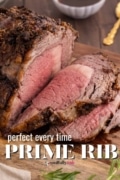
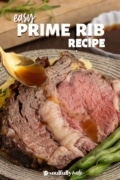
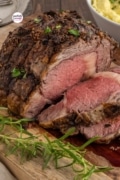












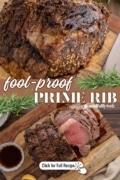
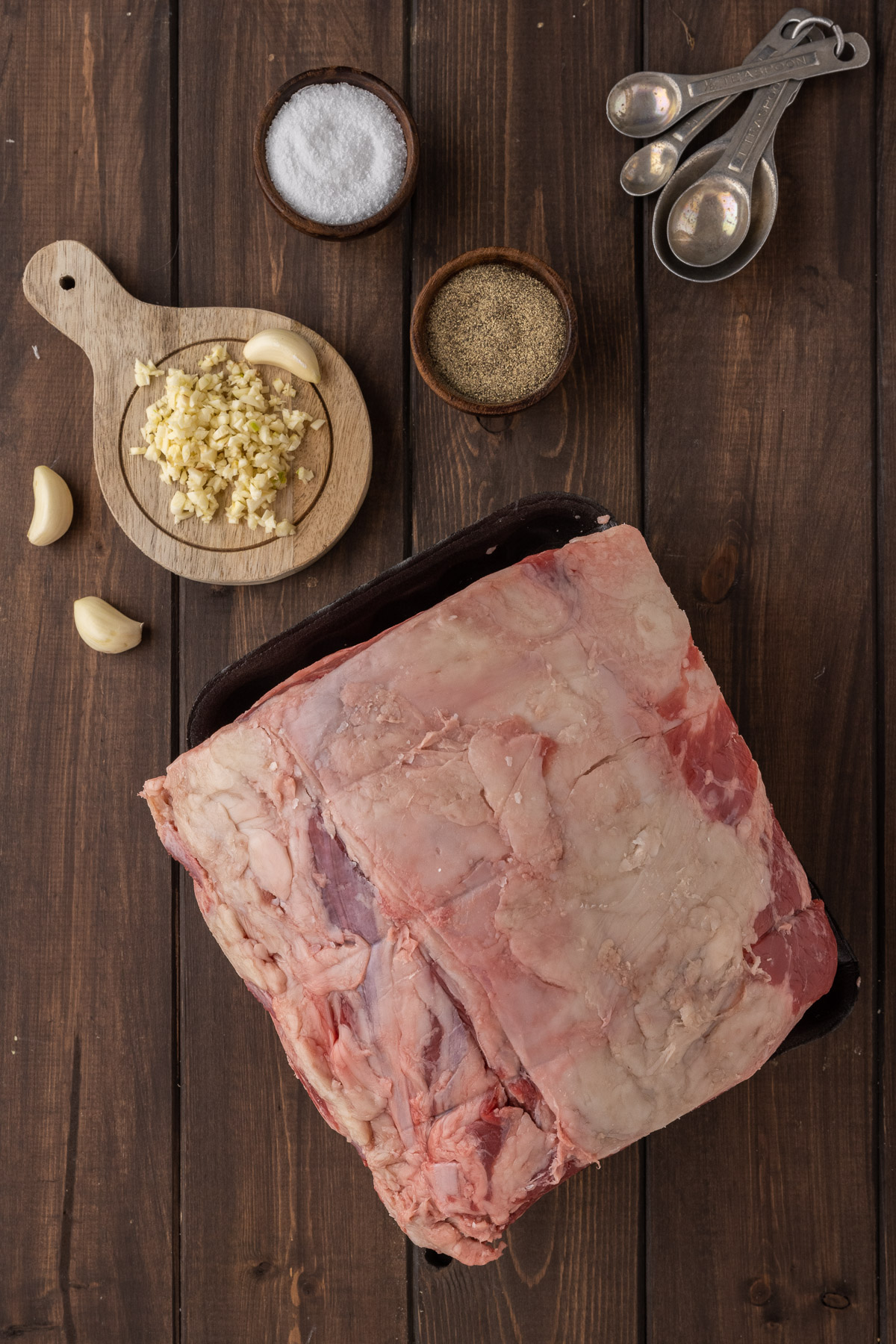
Love your easy, quick and mouth melting delicious recipe. Juicy and tender, the perfect meal for my loved ones.
This turned out to be super flavorful, tender and delicious! Great for a family meal!
Thank you so much!
So tender and flavorful! Definitely saving this recipe for the holidays!
Thank you so much! It is perfect for the holidays!
I have family members who love prime rib, and after reading through your post and recipe I feel like I could prepare and cook prime rib for a holiday or other large family gathering. Thanks for all the tips!
This is perfect for Sunday dinner!
I made this prime rib for Christmas dinner and my whole family raved about it! Thanks so much for sharing the recipe!
This prime rib looks incredible! I love all the garlic and how easy it is to make. Looking forward to trying this elegant and delicious recipe.
Thanks. The detailed instructions ensured a great rib roast!
Prime rib is a new years tradition for my family and I cannot wait to make this one this year! It looks so good!
Beautiful recipe! Absolutely perfect for a cozy Sunday dinner.